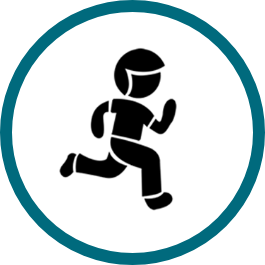Prompt and appropriate care seeking for ARI could prevent over 900,000 deaths of children under five every year.1UNICEF MICS
United Nations Children's Fund This is an occasional behavior that needs to be practiced without hesitation at the onset of infection danger signs.

Care for Pneumonia
Caregivers appropriately manage care for signs and symptoms of ARI in children
Key Points from Global Research
- Successfully improving poor community-based diagnosis and treatment can increase prompt care seeking in households with children under five.
- Helping caregivers understand the symptoms and seriousness of pneumonia in children under five can encourage them to seek care.
Behavior Profile Sample: Care for Pneumonia
A Behavior Profile is a summary analysis of each behavior. This sample draws from global evidence and illustrates the result of using the Create Behavior Profiles Tool to analyze factors, supporting actors and strategies and to ensure logical pathways exist between strategies proposed and factors related to the practice of the behavior. This sample may be used as a starting point or reference for creating Behavior Profiles.
| Improve maternal and child survival | |
|
Caregivers appropriately manage care for signs and symptoms of ARI in children Indicator: Percentage of children born in the five years preceding the survey with acute respiratory infection taken to a health facility
|
Behavior Analysis |
Strategy | ||
|---|---|---|---|
STEPSWhat steps are needed to practice this behavior?
Click on any box |
FACTORSWhat factors may prevent or support practice of this behavior? These should be analyzed for each country context.StructuralAccessibility: Caregivers cannot obtain care for pneumonia because facilities are often far from households and easy transportation is unavailable Accessibility: Caregivers cannot obtain care for pneumonia because services and treatment options are often unaffordable Service Experience: Caregivers are discouraged from seeking care for pneumonia because facilities are often poorly equipped, poorly supplied, or poorly staffed SocialFamily and Community Support: Caregivers do not seek care from a health facility for children with pneumonia because they often lack support from a spouse or other influential social actors Norms: Caregivers do not seek care for pneumonia at a health facility because cultural beliefs often discourage it InternalAttitudes and Beliefs: Caregivers do not seek care for pneumonia at a health facility because they often do not perceive the illness as serious enough to require it Knowledge: Caregivers do not seek care for pneumonia at a health facility because they do not know the symptoms and danger signs of ARI |
SUPPORTING ACTORS AND ACTIONSWho must support the practice of this behavior?InstitutionalPolicymakers: Formulate national policy to provide free treatment for children under five Logistics Personnel: Proactively monitor stock levels and forecast needed medical supplies and drugs CommunityCommunity Leaders: Establish community transport schemes for urgent careseeking HouseholdFamily Members: Encourage caregivers to seek treatment with trained health providers at onset of symptoms |
POSSIBLE PROGRAM STRATEGIESHow might we focus our efforts based on this analysis?Enabling EnvironmentPolicies and Governance: Formulate national policy to provide free treatment for children under five Policies and Governance: Formulate policies that ensure community involvement in how health care facilities are staffed and supervised Systems, Products and ServicesQuality Improvement: Train and equip village health workers to diagnose and treat pneumonia Quality Improvement: Train private pharmacies to recognize and appropriately treat or refer children with symptoms of pneumonia Demand and UseCommunication: Utilize all well-child health touchpoints to work with mothers and families on the recognition of symptoms of childhood illness, including ARI and the need for immediate care-seeking Skills Building: Train and equip community and religious leaders to facilitate careseeking through community mobilization and transport or financing schemes |
Global Status of Accelerator Behavior
Indicator: Percentage of children born in the five years preceding the survey with acute respiratory infection taken to a health facility
The DHS Program Indicator Data API, The Demographic and Health Surveys (DHS) Program


 The Manoff Group was acquired by JSI in 2022.
The Manoff Group was acquired by JSI in 2022.